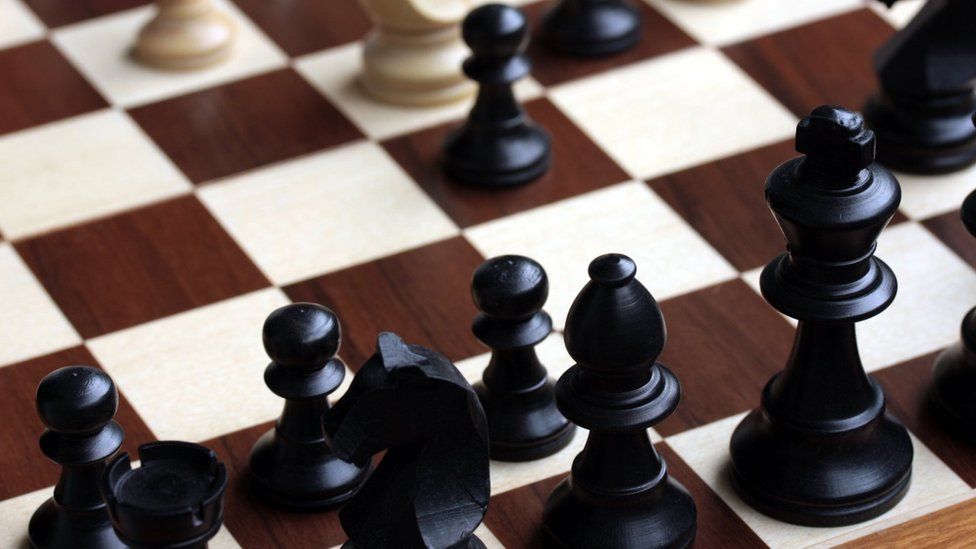World Chess Day: What's so good about the game?
- Published
- comments

Every year on 20 July is World Chess Day, but it's about much more than just playing the board game.
It's been celebrated since 1966, after being set up by the International Chess Federation (FIDE) but has only been recognised by the United Nations (UN) since 2019.
The goal of World Chess Day is to help support international cooperation through people from different backgrounds and cultures coming together to play.
The federation says that as chess is a global game, which promotes fairness, inclusion and mutual respect, it can also be used as an important platform to foster, dialogue, solidarity and a culture of peace between countries.
How do you play chess?
Chess is a two player strategy board game where the aim is to move different types of playing pieces around a chequered square board.
Each side starts with 16 pieces: eight pawns, two bishops, two knights, two rooks, one queen, and one king, and the aim is to capture the opponent's king.
But there are rules about how each of the different pieces are able to move.
About 70% of the adult population (US, UK, Germany, Russia, India) has played chess at some point in their lives.
605 million adults play chess regularly.
King - Moves one square in any direction.
Queen - Moves any number of squares diagonally, horizontally, or vertically.
Rook - Moves any number of squares horizontally or vertically.
Bishop - Moves any number of squares diagonally.
Knight - Moves in an 'L-shape,' two squares in a straight direction, and then one square perpendicular to that.
Pawn - Moves one square forward, but on its first move, it can move two squares forward. It captures diagonally one square forward.
What's the history of Chess?
The game is thought to have been around for a very long time.
The earliest reference to the game comes from a Persian manuscript more than 2,500 years ago, which describes an ambassador from the Indian Subcontinent visiting a king and presenting him with the game as a gift.
Over time the game evolved, rules changed and it spread across the world.
Modern Chess is believed to have been derived from Chaturanga a word that means 'four divisions'.
This could either be referring to the four groups - infantry, cavalry, elephantry and chariotry - that the playing pieces fit into, or the fact that the game at this time was played by four players.
10th Century - The oldest recorded game An ancient manuscript records a chess game between a Baghdad historian and his pupil.
1254 - Chess is banned King Louis IX forbids people from playing this game in France.
15th Century - Chess is now popular The game spreads increasing in popularity. It is even known as the 'royal game' in England.
1834 - First major international Chess event A series of six matches are held between the leading French and British players.
1835 - Standardised Chess sets An Englishman, Nathaniel Cook, establishes a standard design for the chess game set.
1849 - Patented and endorsed After design of the new standard chess set is protected and is named after the famous player Howard Staunton — even today, only sets based on this design are allowed in international competitions.
1861 - Games start to be timed A way of recording time accurately is now possible and so this is introduced into the game.
Who are the most famous chess players of all time?
Norwegian chess grandmaster Magnus Carlsen is probably the most well-known chess player around today.
At just 19 years old, he became the youngest player to become number one in terms of rating, and from 2018 to 2021 he had the longest undefeated streak in chess - 125 games in a row!
This, alongside winning several World Championships over the past several years, makes him a top player in chess history.
Howard Staunton is the most famous British chess player of all time, and was generally regarded as the world's strongest player from 1843 to 1851 and helped give chess the platform it has today.
He was the main organiser of the first international chess tournament in 1851, which made England the world's leading chess centre and later became a leading chess commentator, and won matches against top players of the 1840s.
He also wrote many articles and books that encouraged the development of chess in the United Kingdom, with 1847 Chess-Players' Handbook being used as a reference for decades.
What's the best way to get into chess?
Many people think that the best age for chess learning can be from six to eight years old.
There are some amazingly talented young chess players, like Rami a 10-year-old boy from Syria who earlier this year became Cornwall's youngest ever chess champion, beating most adults who took part.
Last year another boy, Abhimanyu Mishra from the US, broke the record for the youngest ever chess Grandmaster at just 12 years and four months old.
The best way to start is to make sure you know the rules. It's a good idea to review the basic movements for each piece and the special rules of chess before you get started.
Then if you want to get good at it, play lots and lots of games with different people and take time to review and learn from each game.
Think about what you did well, and what can you improve on next time - especially avoiding making bad moves.
Most games are lost by poor decision making so before you move one of your pieces, always double-check to make sure that your king will be safe and that you are not giving away any pieces for free.
- Published27 July 2020
- Published6 July 2021
